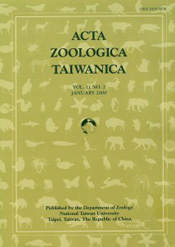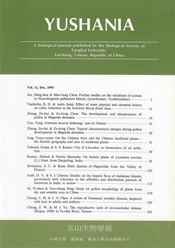Instructions to Authors
Submission of manuscripts
Authors submitting a manuscript do so on the understanding that the work has not been published before, is not being considered for publication elsewhere and has been read and approved by all authors. Submission of manuscripts by the authors means that the authors automatically agree to assign exclusive copyright to the journal if and when the manuscript is accepted for publication. This manuscript shall not be published elsewhere in any language without the written consent of the journal. For reviewing purpose, please specify your manuscript to be either a research article or a short note, and also belong to which one of the following category:
- Taxonomy
- Anatomy and Morphology
- Cell Biology and Physiology
- Ecology, Evolutionary Biology and Animal Behavior
- Genetics, Molecular and Developmental Biology
Reports or notes on New record or Naturalized species with only description and illustations will not be considered for publication. They will require additional experiments or significant information to general readers. For example, the new distribution of a species across biomes will be more attractive than the new distribution across political boundaries.
Manuscripts belong to Checklists and Vegetation surveys, should contain the analysed data or new scientific information to make the study relevant for the Life Science community over the world.
Manuscripts about range extension of species within a country will be deemed as local reports, and the local reports are generally not considered for publication, although exceptions may be possible. Please contact the managing editor before submitting such articles.
Manuscript should be submitted electronically in Microsoft Word format to the Online Submission site (http://mc.manuscriptcentral.com/tai). Alternatively, send to TAIWANIA Editorial Office:
Editor-in-Chief
Dr. Chang-Fu Hsieh
TAIWANIA Editorial Office
College of Life Science
National Taiwan University
No. 1, Section 4, Roosevelt Road
Taipei 106, Taiwan
Email: taiwania@ntu.edu.tw
Form of manuscript
Manuscripts should be prepared in Microsoft Word compatible format or be typewritten, with wide margins of high quality bond paper, using double spacing throughout. The first page should contain only the title, the author's name, and full address. Correspondent author should include name, full address, numbers of phone and fax, and an email address. A proposed running head of no more than 30 characters and keywords of no more than ten words should be included. The title should be brief and contain words useful for indexing and information retrieval. The second page of the manuscript contains the abstract. Subdivision of articles into Abstract, Key words, Introduction, Materials and Methods, Results, Discussion, Acknowledgements, and Literature Cited, is recommended. Abstract should be limited to 250 words. Keep acknowledgements short. All pages should be numbered consecutively in the bottom right-hand corner. The Chinese title, abstract, key words, author's name and full address are no longer required.
Tables
Tables should be typed on separate pages, numbered consecutively with Arabic numbers and arranged at the end of the manuscript. All tables must have titles, legends and descriptive headings and should be understandable without reference to the text. The abbreviations used in tables should be explained.
Illustrations
Illustrations should be limited to materials essential for the text, and line drawings should be used wherever possible. Previously published illustrations are not accepted except under special circumstances. All figures, whether photographs, micrographs or diagrams, should be numbered consecutively and used unit scale bar. Illustrations files should be prepared in Jpeg (at least 300 dpi), TIFF or PNG. You can check the file qualities as following suggestions before you submitting them:
- Line art (e.g., cladograms, botanical illustrations) must be at least 600 pixels per inch (600 dpi).
- Photographs (grayscale or color) must be a minimum of 300 dpi.
- Images with mixed line art and grayscale must be at least 600 pixels per inch (600 dpi).
Please submit figure files separately. Photo- or micrographs which are appearing as a group should be mounted together with small spaces between the individuals, and identified by bold uppercase Arial letters (A, B, C, etc.), not Arabic numerals or lowercase letters. Line drawings must be original works and should be submitted as good-quality prints. They should be drawn clearly in deep-black lines on white background and each illustration should be provided with a concise but descriptive caption. The caption format for composite figures should be, for example: Fig. 1. illustration of Trabrooksia applanata. A: Fruiting bodies. B: Spores, surface view. Abbreviations: fb, fruiting body; s, spore. Scale bar: A = 325 μm; B = 4 μm. The titles of figures should be describe specifically, DO NOT only use species name as the figure title. Color plates may be included as the authors' expense. If possible, reduce your file size but still keep the required high qualities.
Nomenclature of organisms
Scientific names (Binomial Latin names), with authorities, should be used in accordance with the International Code of Nomenclature for Algae, Fungi and Plants or the International Code of Zoological Nomenclature.
- Scientific names are indicated with italic font. Authors of scientific names, should follow The International Plant Names Index (Royal Botanic Gardens, Kew, 2012). Multiple authors of scientific names should be jointed with "&" not with "et".
- For abbreviations of herbaria, consult the website Index Herbariorum (New York Botanical Garden).
A complete description for each new taxon must be provided and should be accompanied by appropriate illustrations. A specific name should not be used without an accompanying capitalized generic name. The generic name for each species should be written in full where it first occurs in the text, and again in the summary or abstract. Where the generic name appears frequently in the text it may be abbreviated by using the initial letter.
Nomenclature of specimens
The citation of specimens should be concise, and only two collections for each county are recommended. Geographic names are put in order of decreasing political magnitude. Only the essential data concerning each specific locality should be given. Collectors are cited by familial name and collected number. If there is no collection number, the year of collection should be given. Herbaria are designated by its acronym according to the current edition of Index Herbarium.
Abbreviation and Units
Use SI units as far as possible. Only standard abbreviations should be used. Abbreviations should be checked for consistency. Periods are used after all abbreviations except metric measures, compass directions, and herbarium acronym. A single blank must always follow after a period, colon, semicolon, or comma (except within numerals, standard abbreviations such as e.g., i.e., l.c., s.str., s.l., and between numerals and units of measure: "9 mm" not "9mm", but "9%" not "9 %"; x = 9 not x=9. Use an en-dash but not a hyphen between page numbers and measurements, "50–60" not "50-60." (You can easily type an en-dash by compound "Ctrl" and "-", whereas the minus symbol is the one locate at the right edge of the qwerty keyboard).
Literature Cited
The list of References should include only publications cited in the text. The references should be cited in alphabetical order under the first author's name, listing all authors, the date of publication, the full title of the paper, the abbreviated title of the journal, the volume number and the first and last page numbers. References to books should include the number of edition, the name of the publisher, city and country of publication, pages numbers. In the text a reference should be quoted by the author's name and the date placed in brackets, e.g. Chen and Huang (1980) or both author's name and the date placed in brackets, e. g. (Chen and Huang, 1980). Please consult recent articles in the journal for further information.
Chen, S.-H., Huang, T.-C. 1980. Aeropalynological study of Taipei Basin, Taiwan. Grana 19: 147–155.
Lin, C.-Y., Guilfoyle, T.J., Chen, Y.-M., Nagao, R.T., Key, J.L. 1974. The separation of RNA polymerase I and II achieved by fractionation of plant chromatin. Biochem. Biophys. Res. Commun. 60: 498–506.
Robson, Narman K.B. 1996. Guttiferae. In: Huang, T.-C. et al. (eds.), Flora of Taiwan, 2nd ed. 2: 694–714. Editorial Committee, Dept. Bot., NTU, Taipei, Taiwan.
Ackery, P.R., Vane-Wirght, R.I. 1984. Milkweed Butterflies, Cornell Univ. Press, New York, USA. 425 pp.
Huang, T.-C. 1972. Pollen Flora of Taiwan. Dept. Bot., NTU, Taipei, Taiwan. pp. 63–64.
Proof and Reprints
For accepted paper, we would like to receive your manuscript and artwork in electronic form. Please DO NOT embed figures in Word document. Save vector graphics (line art) in Portable Document Format (PDF), or bitmap files (half-tones/photographs) in JPG, PNG, GIF or TIF. The maximum printed size for a full page figure is 16.7 cm by 22.3 cm, and the resolution of figures should be at least 300 dpi (at reproduction size, depending on the type of figure you use). Combination figures can also be saved in jpg or metafile (EMF) format. Corresponding authors will receive page proof and will be charged for alternations on illustration. Reprints over 20 may be purchased at cost plus postage.
Copyright
Copyright of all published articles belongs to the Taiwania Editorial Office. Copyright transfer is effective once the author receives written confirmation of acceptance of the manuscript.Taiwania provides immediate open access to its content on the principle that making research freely available to the public supports a greater global exchange of knowledge. Taiwania articles are published with open access under the Creative Commons Attribution-NonCommercial-NoDerivs (CC BY-NC-ND), which means that, upon publication, the author(s) retains copyright, but the content is free to download, distribute, and adapt for commercial or non-commercial purposes, given appropriate attribution to the original article. Full-text access to scientific articles of the journal is presented on the official website taiwania.ntu.edu.tw.
Copyright Assignment Form must be downloaded and completed for all accepted paper before publication.
Publication Fee
To offset costs associated with peer review management, journal production and online hosting and archiving, Taiwania charges a fee (Article Publishing Charge, APC) when the article has been accepted. The Article Publishing Charge is USD 100, excluding color pages charges (USD 100 per page), over 20 pages (US$10 per page) and reprints, which will be defrayed by the authors. Author with funding support was encourge the payment of publication fee (US$ 100 per article) which support the open access service. Taiwania also provided direct fee assistance for authors unable to pay all or part of their publication fees if the justification accepted (see Taiwania payment policy and conditions).
Announcement
Journal Resources
Journal Impact Factor is 1.0
5 years JIF = 0.9
Source: Clarivate 2025#JCR2025






